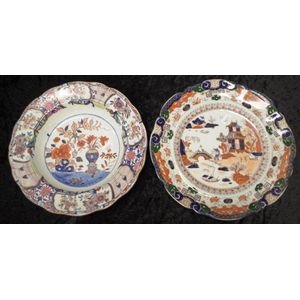Antique Mason's Ironstone Soup Bowls
Two various antique Mason's ironstone soup bowls including: Georgian ironstone bowl, painted Flower Vase decoration, impressed mark to base, circa 1825, and Victorian plate, Pagoda decorated, mark to base, diameter 25 cm, and 26 cm
You must be a subscriber, and be logged in to view price and dealer details.
Subscribe Now to view actual auction price for this item
When you subscribe, you have the option of setting the currency in which to display prices to $Au, $US, $NZ or Stg.
This item has been sold, and the description, image and price are for reference purposes only.
- Ironstone China - Credit for the invention of ironstone china is generally accorded to Charles Mason in 1813. Charles Mason was one of the two sons of Miles Mason who founded the Mason works in 1802, and ran the business with his brother George Mason.
Ironstone was a heavy hard earthenware which was slightly translucent, its strength supposedly coming from a very small quantity of iron slag added to the mixture. The additional strength enabled the company to make larger objects that were not susceptible to breakage.
The company manufactured dinner wares, toilet sets, tureens, jugs and so on, and the most popular patterns were blue and white, floral and Oriental Imari style colours.
The trade name "Patent Ironstone China" was registered by the company in 1813, but the patent was only valid for 14 years and was not renewed, enabling other potteries to use the word "ironstone" in describing their wares.
Mason wares are generally well marked with "Mason's Patent Ironstone China" . - Circa - A Latin term meaning 'about', often used in the antique trade to give an approximate date for the piece, usually considered to be five years on either side of the circa year. Thus, circa 1900 means the piece was made about 1900, probably between 1895 and 1905. The expression is sometimes abbreviated to c.1900.
- Georgian - As an English stylistic period, Georgian is usually taken to cover the period from George I (1714) to the Regency of Prince George (1811-20), although the period from 1800 to 1830 is sometimes designated as the Regency period. During the Georgian period the great English cabinetmakers and designers such as Chippendale, Hepplewhite, Adam Sheraton etc., were all active.
Therefore there isn't a single 'Georgian style' as such and to say something is 'Georgian', usually means it was made between 1714 and 1830. This assumes we discount George V and George VI, both being from the 20th century.
The styles popular at the time of each reign were:
George I (1714-1727) saw out the last years of the Baroque period.
George II (1727-1760) reigned during the Rococo period.
George III (1760-1820) saw the last gasp of the Rococo, all of the early Neo-Classic 'Adam style' and most of the later neo-Classic 'Regency style'.
George IV (Prince Regent 1820-1830)encompassed the last of the 'Regency' style.
William IV's reign (1830-1837) was something of a no man's land (stylistically) and he wasn't a 'George' anyway. He covered the last glimmerings of 'Regency' and the start of the 'Victorian' style. - Victorian Period - The Victorian period of furniture and decorative arts design covers the reign of Queen Victoria from 1837 to 1901. There was not one dominant style of furniture in the Victorian period. Designers used and modified many historical styles such as Gothic, Tudor, Elizabethan, English Rococo, Neoclassical and others, although use of some styles, such as English Rococo and Gothic tended to dominate the furniture manufacture of the period.
The Victorian period was preceded by the Regency and William IV periods, and followed by the Edwardian period, named for Edward VII (1841 ? 1910) who was King of the United Kingdom and the British Dominions and Emperor of India for the brief period from 1901 until his death in 1910.
This item has been included into following indexes:
